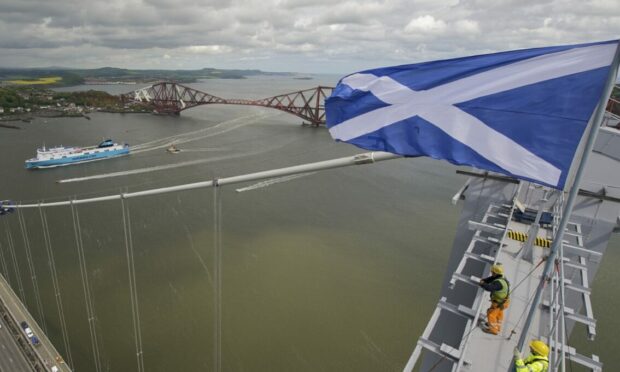The team behind ambitious plans to reconnect Scotland by ferry from Fife to the rest of Europe have sent a plea for governments to stump up the cash to make it a success.
Backers including ferry firm DFDS Seaways, port authorities in France, hauliers such as Dyce Carriers and campaigning politicians all believe passengers could set sail as soon as May.
But in a progress report today, Ptarmigan Shipping director Derek Sloan, the Scottish businessman behind the project, said governments have to invest start-up money.
“Without this being available, then it is highly unlikely that current stakeholders will implement the route,” he warned.
It is a note of caution in an otherwise upbeat briefing on the years of effort going towards reinstating a ferry service from the Port of Rosyth.
Switch from Zeebrugge to Dunkirk
The Courier revealed in October that Mr Sloan’s team’s focus had switched from Zeebrugge in Belgium to Dunkirk in France.
If the Rosyth plan is successful, Scottish holidaymakers could soon disembark in France alongside passengers already making use of links from Rosslare in Ireland and Dover in England.
Mr Sloan was a key player in the growth of the Irish links, dubbed “Brexit busters” for their ability to get freight straight to market without passing through the UK.
In his report for the new year, Mr Sloan highlights the groundswell of support along with key players for the plan he dubs “project brave”.
As well as asking for government help, he describes major economic benefits to exporters, importers, employment, tourism and a reduction of the carbon footprint.
The team is not revealing how much of the money is needed from government, but hopes to have further talks at Scottish and UK level.
Additional talks are needed on border control before the ferries can start making the crossing.
Mr Sloan said: “I see this as unfinished business and we must take the opportunity now. The economic, environmental and connectivity benefits of the route will be transformational for Scotland.”
Backers include DFDS Seaways vice president Kasper Moos who said he “firmly” believes the route can operate sustainably with one vessel sailing three returns a week.
It could grow to two vessels and six return sailings a week by 2030.
He added: “For this to happen there remain some obstacles to be overcome with port infrastructure, border force and, not least, start-up funding.”
Richard Workman, from Aberdeen-based trucking company Dyce Carriers, said: “Most of our trucks are running 400 miles round trip to drop trailers off and collect loaded trailers bound for central Scotland.
“Having a service into Rosyth would reduce the carbon footprint significantly and give our customers a vital link into Scotland.”
The Port of Dunkirk said it is convinced and “fully committed”, while Dunkirk local government welcomed opportunities to increase tourism and trade with Scotland.
The Rosyth link is targeted at holiday passengers travelling by car or motorhome, as well as hauliers.
Backers hope it will be a clear alternative to the nearest existing route from Newcastle which takes vehicle and walk-on passengers, along with freight, to Amsterdam.
Dunkirk, around 200 miles further south along the coast from Amsterdam, is close to Calais. The port is just over two hours from Paris on the fastest trains, or three and half hours by car.
The campaign to bring the ferry back is supported by Douglas Chapman, MP for Dunfermline and West Fife.
He said: “This is more than an emotional reaction to having a direct line into Europe, it’s driven by a hard-headed decision that we must make to grow our economy, boost exports and support our tourism sector by attracting more visitors to Scotland through this route.”
Fife council economy spokesman Altany Craik said said the local authority supports the plan.
A spokesman for government agency Transport Scotland said: “We will continue to engage with port operators and others to explore how that might be delivered so that Scottish exporters have more direct routes to market and that passengers have viable alternatives to air travel. Any new service will require to be delivered on a commercial basis.”
First link since 2010
There used to be a passenger ferry between Rosyth and Zeebrugge but it was shut down in 2010.
Freight on the line was ended in 2018 by carrier DFDS after a fire on board one of its ships.
The Finlandia Seaway’s engine room was seriously damage by the blaze.
An agreement was signed with DFDS in 2022 to revive the link with Ptarmigan Shipping, which gave the project a push.



Conversation